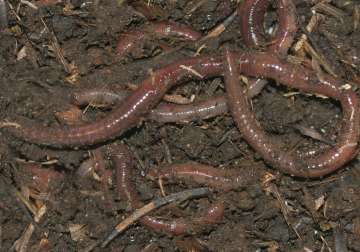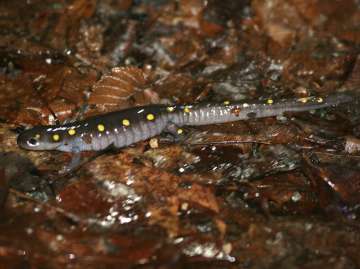

PHOTO COURTESY OF GARRY KESSLER
These young earthworms are burrowing in a local garden compost pile.
March 19, 2010, Page 14,15
NATURE NOTES
By Annie Reid
Westborough Community Land Trust
Earth stirs in March
Nature continues to stir in March, but many of those stirrings take place where we’re unlikely to see them.
Hints of unseen activity come from traditional names for the March full moon – the worm moon or the sap moon. These names come down to us from Native Americans and early European colonists, from a time when people’s lives were closer to nature’s rhythms than ours are today. Look for the full moon on March 30.
The earth begins to stir as the ground thaws. Plant life stirs as sap starts to flow unseen in the trunks of trees, in response to lengthening days and warmer temperatures. Some trees may bloom by the end of the month, such as red maples (Acer rubrum) near wet areas. You can already spot pussy willows (Salix discolor).
Underground stirrings often suggest “worms” to us. We tend to think of “earthworms” and the robins that arrive on our lawns to eat them in the spring. The worm we usually have in mind is the common earthworm (Lumbricus terrestris), also known as the common nightcrawler. But many kinds of earthworms exist.
Our common earthworm is fairly large (5-8 inches) and reddish-brown. It lives in deep burrows (up to 6 feet down) and comes up to feed in the top layers of soil and the leaf litter on the surface. Other kinds of earthworms – many small (1-3 inches), reddish-brown ones – live and feed in the leaf litter. Yet others – small (1-5 inches) and usually light gray – live and feed in the top layers of soil.
Surprisingly, none of the earthworms in Massachusetts is native. Even the common earthworm has another name: the common European earthworm. Most of the earthworms in our area came from Europe with the plants and ship ballast of early settlers.
Why don’t we have native earthworms? Blame the glaciers, the scientists tell us.
Earthworms were wiped out from the whole area that was scraped by glaciers about 25,000-15,000 years ago. This area includes Massachusetts and the northeast, the upper Midwest, and parts of the northwestern U.S. Places south of the glaciers still have native earthworms, but we don’t.
We’re in the habit of thinking of earthworms as good creatures – decomposers that mix, aerate, enrich, and improve the soil for agriculture. But think again.
Recent science suggests that non-native earthworms may not be beneficial everywhere. In areas scraped by glaciers, earthworms can be good for agricultural lands and for urban land that human use has compacted and degraded, but they may actually be harmful to other natural areas where plants and animals have been thriving without them for thousands of years. In other words, some types of forests do better without them.
These days non-native earthworms may even be considered invasive in some forests. In particular, a certain type of hardwood forest found in Minnesota, parts of Wisconsin and Michigan, and parts of New York and Maine may be in danger from them.
Does this apply to our familiar common earthworms? It does. These earthworms are famous for “eating dirt” as they burrow through the soil. Through their mouths, they take in soil particles, leaf and plant debris, fungi, bacteria, and other microscopic organisms. They also come to the surface at night and pull dead leaves down into their burrows to eat them. As everything passes through the long tube that is their digestive tract, it gets broken down and their bodies absorb the nutrients. Finally the remains pass out the other end as worm castings.
In this process, earthworms digest fallen leaves and decaying plant matter that local native plants and other organisms may depend on, particularly in forests that have prospered for thousands of years (since the glaciers melted) without earthworms. As new arrivals in these forests, earthworms recycle plant matter much faster than the rest of the forest is used to. In short, the earthworms eat up what native plants, tiny animals, and microorganisms need – and this can change how well the whole forest grows.
What about our local forests? Are they in danger from earthworms? At this point, it’s unclear. Most of our soils in eastern Massachusetts are acidic, which doesn’t favor earthworms. Westborough’s forests have lots of oak trees, and earthworms prefer other types of leaves, such as maple (which we also have). Time and further research should give us more information.
For now, the safe thing to do is to avoid releasing earthworms in the woods. People who fish with earthworms as bait and people who use earthworms in their gardens or compost piles should be especially careful with them.
In any case, common earthworms are interesting creatures. They have no lungs but they breathe through their skin, which needs to stay moist – but not too moist, as we see when rain floods the soil and earthworms come to the surface, probably to avoid drowning.
They have no skeleton, but a fluid-filled space inside their body gives them some stiffness. Their bodies are made up of about 150 ring-like segments, which you can see in a quick look. We may feel some kinship with them, if we think of our own backbone, also made of many segments – our vertebrae.
The earthworm’s segments bear small bristles that the worm can use to anchor parts of itself in the soil. This kind of grip comes in handy.

PHOTO COURTESY OF GARRY KESSLER
One rainy night last weekend, this spotted salamander came up from underground at the Headwaters Conservation Area and headed toward a vernal pool to breed.
If you’ve watched an earthworm crawl, you’ve seen how it moves by stretching out and shortening different parts of its body. It has circular muscles that contract to stretch and thin out its body and lengthwise muscles that contract to shorten its body. While it does this, it digs in with its bristles at back or front to hold one end in place.
Earthworms don’t have kidneys like we do, but each segment has a tiny structure that’s remarkably similar to structures inside our own kidneys.
Earthworms have no eyes, but they do have cells on their bodies that detect light. Their reddish-brown color helps to protect them from sunlight when they are at the surface.
Earthworms have five simple hearts in the form of blood vessels that pump.
How do they reproduce? Each earthworm has both male and female parts. When two earthworms mate, they exchange sperm. Later on, each one transfers the newly acquired sperm to its own eggs and sheds a cocoon-like egg case containing the fertilized eggs. The new earthworms develop in the safety of this cocoon.
Earthworms can also grow back some parts of their bodies. If the robin on your lawn gets only the front part of the worm – as might happen when the worm digs into the soil with the bristles on its back end – the worm may re-grow its front end. In the meantime, it survives without its tiny brain.
Other animals besides robins eat earthworms. One is the spotted salamander (Ambystoma maculatum). This month these 8-inch salamanders come up from underground, where they’ve spent the winter below the frost line in another animal’s burrow. On a rainy night, they crawl off to breed in the same vernal pool where they themselves hatched.
Happy spring!